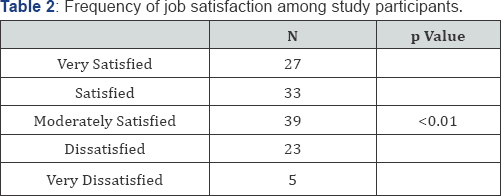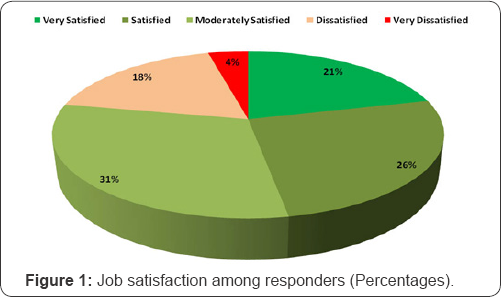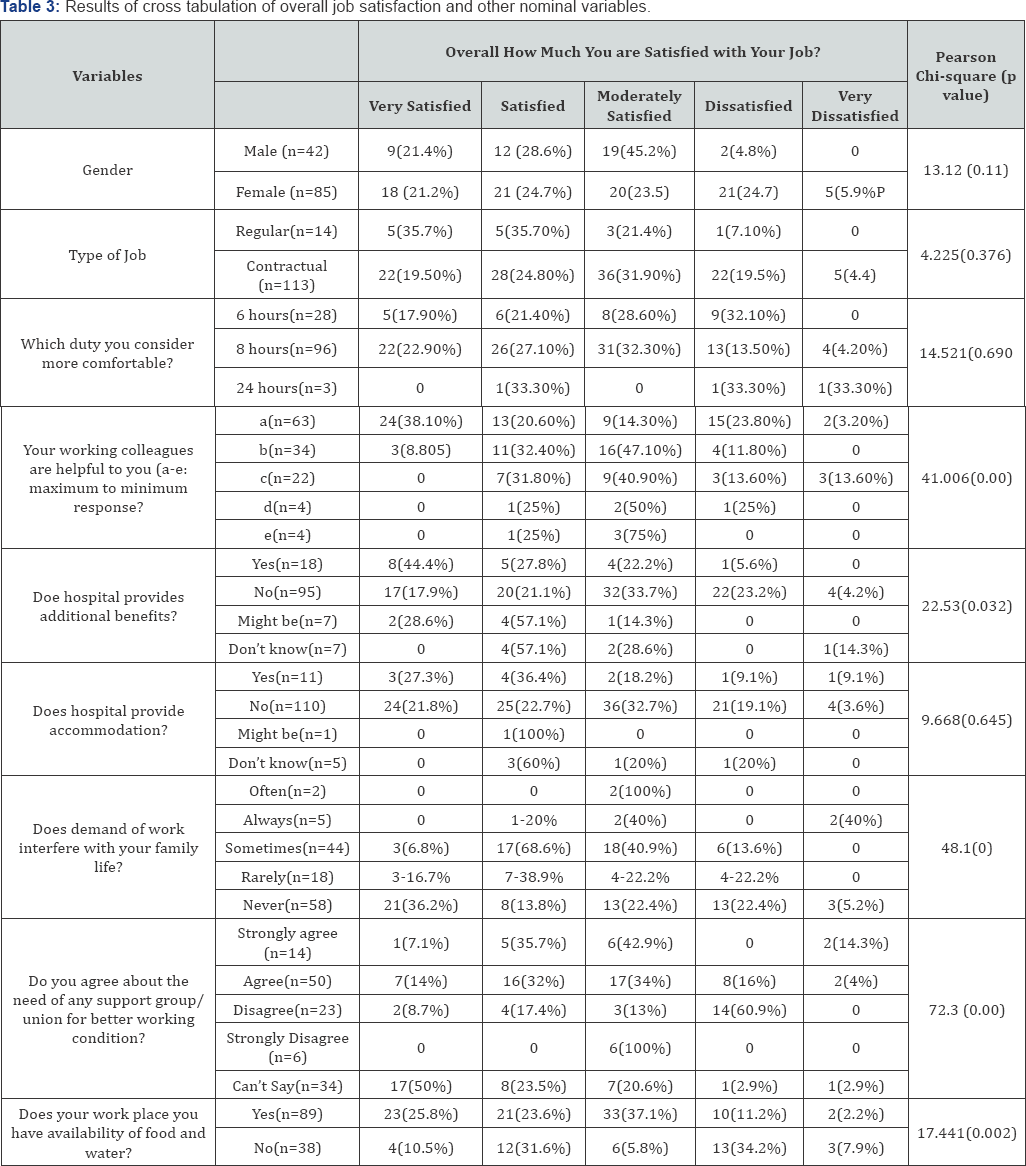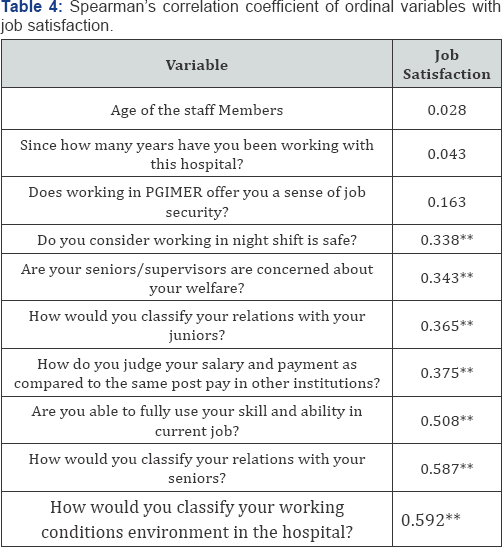Job Satisfaction and Quality of Work Life among Receptionists and Staff of Medical Record Department of a Tertiary Care Teaching Hospital in North India
Ashok Kumar1 and Yatin Talwar2*
1Advanced Cardiac Centre, India
2Department of Hospital Administration, India
Submission: August 12, 2017; Published: August 21, 2017
*Corresponding author: Yatin Talwar, Department of Hospital Administration, PGIMER, Chandigarh, India, Email: drtalwaryatin@gmail.com
How to cite this article: Ashok K, Yatin T. Job Satisfaction and Quality of Work Life among Receptionists and Staff of Medical Record Department of a Tertiary Care Teaching Hospital in North India. JOJ Nurse Health Care. 2017; 3(4): 555619. DOI: 10.19080/JOJNHC.2017.03.555619
Abstract
Background: There is a lack of studies to understand the satisfaction levels of public dealing staff and staff of medical record departments of a hospital. Significant factors in association with job satisfaction could highlight the targeted areas affecting the quality of work life and hence the work productivity. The primary objective of this study was to assess the job satisfaction and quality of work life of receptionists and staff of medical record department. The secondary objective is to determine key areas affecting these job satisfaction levels.
Material and Methods: The study was conducted among the receptionists and staff of medical record department. A cross sectional survey was conducted among 127 subjects. Data were collected in a self-administered semi-close-ended questionnaire. Besides the demographical data related to age, sex and distance of residence, there were 20 questions with prefilled choices related to duration of job, format of job, utilization of skills and ability, relation with the seniors and juniors, and facilities provided by the hospital. Job satisfaction was measured on a five point ordinal scale (Very satisfied to Very dissatisfied). Cross tabulations and chi-Square test of significance was carried out to explore the significant associations of job satisfaction with other independent nominal variables. Spearman’s correlation was calculated between job satisfaction and ordinal variables using statistical package for social sciences.
Results: The frequency of gender showed female preponderance with twice the females among 127 responders. Majority of the responders were on contractual (89%) agreement. 87.4% of the responders were less than 40 years of age. 78% of the responders scored moderate to very satisfy. A significant association was observed between Job satisfaction with gender, whether the colleagues were helpful, hospital provides staff health, demand of work interfere with the family life, need of support groups, and availability of food and water at work place. However, no association was observed between job satisfaction and regular or contractual employment and duration of shifts. Safety and working conditions in the hospital, relation with seniors and juniors, similar pay structures on same post in other organizations, utilization of skills and ability and the concern of the supervisors about the welfare of staff members were significantly positively correlated with the job satisfaction. Importantly, the responders with more work related stress episodes scored less in job satisfaction. The stress levels were found significantly higher in females compared to males (p<0.05).
Conclusion: The findings of the present study gave evidence contrary to the common belief that on being regular or contractual job associates with the job satisfaction. The work related stress needs to be addressed in order to improve job satisfaction and work related quality of life
Keywords: Stress; Quality of work life; Productivity in public sector; Hospital administration; Interpersonal relationship; Hospice
Introduction
Hospitals are public dealing places with staff members in widely distributed roles from physicians to cleaners. Job satisfaction and work-related quality of life (WQL) has been an issue of concern and of thorough research during the past decades [1-8]. Work place facilities, attitude and leadership qualities of supervisors, operations, and general contextual factors of the setting, all reflect in viewpoint on job satisfaction and WQL of the staff members [9-11].
Studies have reported that work productivity is directly associated with the level of job satisfaction. Previous reports have also shown that job satisfaction of employees is a strong and consistent predictor of organizational success [12-14].
As the understanding is growing about the relations of employees’ job satisfaction and growth of the organizations, there is enhanced interest in public health researchers to study job satisfaction among health care providers. Hence in health care sector, numerous studies have reported the job satisfaction and QWL of nurses and primary physicians [4,5,15-20].
The studies on job satisfaction have highlighted that the working environment involves a plethora of risks for the psychosomatic integrity of the employees [21,22]. Such studies have great impact on formulating a guiding mechanism for the organizations to provide safe and satisfying working conditions in order to enhance both quality and quantity of their employees' performances.
Reception staff is an important first line position in any organization. Staff of medical record department manages this interaction among patients and receptionists. The offices of public dealing including hospital spend lot of financial and administrative potential for the management of receptionists. In hospitals, they are the first point of contact for the patients and their attendants. Greeting and directing patients will impress the image of the hospital on patients and attendants minds. Besides, managing the first interaction of clients with the receptionists, staff of medical record department of a hospital is also involved in the duties related with issuing of registrations in OPD, the birth and death certificate to the attendants. Both of these duties are an important integral part of the hospital in providing quality services to the clients. However, their role has not been widely researched.
A previous study has highlighted that helping patients is the primary role of the receptionist [23]. In the context of teamwork in hospitals little has been researched specifically about the role of receptionist and staff of medical record department.
A small number of research studies in the literature have examined the associations between job satisfaction and organizational commitment [24]. The literature is lacking about studies pertaining to the role of supporting staff in the hospitals. Majority of the studies, whatever little has been published, comes from the developed countries. The present study was planned as no study have reported from Indian subcontinent related to job satisfaction of receptionists and staff of medical record department to the best of our knowledge. With this background, in first of its kind study from a premier tertiary care hospital, the present study was designed to assess the job satisfaction and QWL of receptionists and staff of medical record department. The study also focused on analyzing the key determinants of Job satisfaction and QWL.
Materials and Methods
This study was a descriptive cross sectional survey conducted on the receptionists and staff of medical record department of the Institute. Ethical permission was obtained from the author's institute.
Sample
It this single centre study, the study population comprised receptionists and staff of medical record department. The subjects were recruited regardless of the employment contract, age, gender and total work experience. The staff members not willing to fill the questionnaire were excluded from the present study. The final sample comprised 127 participants.
Measurements
The data were recorded in a self-structured semi-close- ended questionnaire. Besides demographical information related to age and gender, there were 20 structured questions with prefilled options related with the work environment, support from colleagues and interpersonal satisfaction level. In order to avoid the bias of data entry, the data collection and data entry was made by different individuals at one time. The study participants were not known to any of the researcher involved in the data collection and entry. The consent was obtained from all participants.
Data analysis
The variables are categorized into the scalar, nominal and ordinal. Categorical variables are expressed as absolute and relative frequencies. For the purpose of this study, Job satisfaction and QWL was operationally defined by the question «Overall, how satisfied are you with your job?» Employees rated job satisfaction from very dissatisfied to very satisfied using a five point Likert scale (1-Very satisfied, 2-Satisfied, 3-Moderately satisfied, 4-Dissatisfied and 5-Very dissatisfied). Influencing factors on job satisfaction were analyzed using the Mann-Whitney Test or the Kruskall Wallis Test. The associations among nominal variables with Job satisfaction and quality of work related life was assessed by cross tabulation followed by the chi square test of significance. The correlations between ordinal variables and job satisfaction were calculated by using Spearman’s correlation coefficient. A two-sided p value of less than 0.05 was considered statistically significant. The Statistical Package for Social Sciences (SPSS) program, version 16.0 (Chicago, IL, USA) was used for statistical analysis.
Results

The responders were mainly women (66.9%). 87.4% of the responders were less than 40 years of age. Majority of the responders were on contractual (89%) agreement. The demographical details of the responders are presented in Table 1.

The subscales of the job satisfaction and work-related quality of life are measured in a scale from 1 to 5 (Table 2). Grades that tend toward 1 imply better health-related quality of life on the total scale. From the findings shown in Table 2, it is evident that 78% of the responders scored moderate to very satisfy on job satisfaction (Figure 1).

It is observed from the data 50.4% of the staff members were working for less than 5 years at the time of assessment. Shifts of 8 hours duration was favorable (75.6%) over 6 hours (22.0%). Majority of the staff members have inhibition on working in the night shifts (38.65) on account of safety. This attitude may be due to more number of female responders. However, 30.6% of the responders scored maximum on the overall safety in the hospital. 42.6% of the subjects scored highest on the utilization of skill and ability on the job. This is an important aspect and has long been associated with QWL in previous studies. 70.4% responded negatively when asked about the additional benefits provided by the hospital. 86.6% have to arrange their own accommodation. The additional hospital benefits are biased to the regular employs and as the present study have majority of the contractual staff, the response is obvious.
The cross tabulation output of nominal variables with job satisfaction is presented in Table 3. The chi-square value associated with p<0.05. A significant association was observed between Job satisfaction with gender, whether the colleagues were helpful, hospital provides staff health, demand of work interfere with the family life, need of support groups, and availability of food and water at work place. It is important to note that the level of job satisfaction was not associated significantly with being on regular or contractual employment and duration of shifts.

The spearman's correlation coefficients of ordinal variables with job satisfaction are presented in Table 4. Figure 2 helps in understanding the strength of correlation of job satisfaction with different independent variables of the questionnaire.


Amongst ordinal variables, safety and working conditions in the hospital, relation with seniors and juniors, similar pay structures on same post in other organizations, utilization of skills and ability and the concern of the supervisors about the welfare of staff members were significantly positively correlated with the job satisfaction. Age, duration of Job and sense of job security were not correlated with job satisfaction. Importantly, the responders with more work related stress episodes scored less in work related quality of life. When the work related stress was assessed in relation to gender as independent variable, females reported significantly more episodes of work related stress as compared to males.
Discussion
Human resources are the integral part of the any organization and are the most important factors for effectiveness and efficiency. Without the committed employees’ efforts, an organization cannot grow [25]. Job satisfaction, QWL, and commitment to their organizations have now been viewed as major determinants of the success of any organization. Moreover, job satisfaction and commitment are critical to retain and attract well-qualified employees [24]. There have been different definitions of job satisfaction, but widely it is defined as 'the extent to which people like or dislike their jobs'. It is an employee's affective reaction to a job, based on a comparison between actual outcomes and desired outcomes.
Similar to various other sectors, health care systems are no different to believe the employees job satisfaction and organization commitment as critical parameters to their own growth. The present study is a unique one to report the job satisfaction and QWL of receptionists and staff of medical record department of a premiere tertiary care hospital of North India. For this, qualitative methods are the most suited and were chosen to understand receptionists' perspectives [26].
Studies from India are scarce related to job satisfaction in health care system. Those studies are related to job satisfaction among nurses [27,28], physicians [5,22,29,30], medical teachers [31,32], medical interns [33], and pharmacists [34]. Since studies are lacking for the job satisfaction among receptionists and staff of medical record department, the results of the present study have inappropriately been compared with the studies on hospital nurses, physicians, physiotherapists etc. The findings of this study indicate that the type of job have no association with the job satisfaction. It had been reported earlier the being on permanent position is significantly correlated with higher job satisfaction [35]. Present finding is in contradiction to the common belief and published evidence. Commitments in duties of any staff, dealing with public can be assessed by counting the number of complaints received. In the present study, 78% responders were moderate to very satisfied, and no complaint lodged against them in the last two years speaks about their commitment level.
Also, in contrary to the previously published report where the salary structure was found to be associated with the job satisfaction [36,37], present data have shown no association between job satisfaction and salary structure. However, such comparisons are more appropriate with employees of similar cadre.
In physiotherapists and nursing staff job satisfaction have been reported to be correlated with age, gender, marital status, work experience years, type of employment, salaries received, number of children, educational level and work experience (years) [24]. However, the findings of the present study suggest that there is no correlation between job satisfaction and age, type of employment, and work experience.
Supervisory support has been associated significantly with job satisfaction and is reported in literature [8,11,3842]. Present study also found the similar correlations where supervisory support was associated with job satisfaction. This is an important observation which validates the previous findings that showed the importance of communication, empowerment, autonomy, and trust in the workplace. Also, a previous study on public health nurses highlighted that vertical communication and collaboration between supervisors and subordinates significantly increased job satisfaction [15].
Job stress is a critical parameter reported in literature. It significantly affects the QWL and organizational growth. Similar to the findings of a previous Indian study on nurses [27], present study also identify that job related stress episodes were negatively correlated with the job satisfaction and QWL. It is beyond the scope of this article to explore the complex personal and emotional factors related to stress. The influence of gender has been studied in literature. A previous study on job satisfaction among staff of medical record department highlighted that there is no association of gender with job satisfaction [43], similar results were reported in a recent study of urologists [1]. The present data on receptionists and staff of medical record department suggested no association of gender with job satisfaction. These findings are contractor to the result of a previous study on health care professionals [44] and dentists [45]. However, it is evident from the present study that stress association of job satisfaction is gender biased.
Conclusion
Although the importance of receptionists and staff of medical record department have been acknowledged globally, studies to understand their work related quality of life and job satisfaction are lacking. The support of administrators to the studies related to understand the issues related to the work related quality of life will lift the moral of the staff members. Present study gave evidence that job satisfaction is a multidimensional construct and is a product of the global evaluation of one's work place and context. To our knowledge, this is the first report on the job satisfaction of receptionists and staff of medical record department from India. This report provides valuable from these staff members about how they view their work environment. The work related stress episodes have been the only significant hurdle in job satisfaction of the employees of the present study. The results of this survey will be used as baseline measures against which the findings of future job satisfaction surveys can be compared. Further studies may be planned at other sites to validate the indentified factors.
References
- Spencer ES, Deal AM, Pruthi NR, Gonzalez CM, Kirby EW, et al. (2016) Gender Differences in Compensation, Job Satisfaction and Other Practice Patterns in Urology. J Urol 195(2): 450-455.
- Makabe S, Takagai J, Asanuma Y, Ohtomo K, Kimura Y (2015) Impact of work-life imbalance on job satisfaction and quality of life among hospital nurses in Japan. Ind Health 53(2): 152-159.
- Fang P, Luo Z, Fang Z (2015) What is the job satisfaction and active participation of medical staff in public hospital reform: a study in Hubei province of China. Hum Resour Health 13: 34.
- Al Maqbali MA (2015) Job Satisfaction of Nurses in a Regional Hospital in Oman: A Cross-Sectional Survey. J Nurs Res 23(3): 206-216.
- Sharma M, Goel S, Singh SK, Sharma R, Gupta PK (2014) Determinants of Indian physicians' satisfaction & dissatisfaction from their job.
- Kumar P, Khan AM (2014) Development of job satisfaction scale for health care providers. Indian J Public Health 58(4): 249-255.
- Bhatnagar K, Srivastava K (2012) Job satisfaction in health-care organizations. Ind Psychiatry J 21(1): 75-78.
- Campbell SL, Fowles ER, Weber BJ (2004) Organizational structure and job satisfaction in public health nursing. Public Health Nurs 21(6): 564-571.
- Negussie N, Demissie A (2013) Relationship between leadership styles of nurse managers and nurses’ job satisfaction in Jimma University Specialized Hospital. Ethiop J Health Sci 23(1): 49-58.
- Lipinska-Grobelny A, Wasiak K (2010) Job satisfaction and gender identity of women managers and non-managers. Int J Occup Med Environ Health 23(2): 161-166.
- Phillips E, Hays JR (1978) Job satisfaction and perceived congruence of attitude between workers and supervisors in a mental health setting. Percept Mot Skills 47(1): 55-59.
- Kvist T, Mantynen R, Vehvilainen-Julkunen K (2013) Does Finnish hospital staff job satisfaction vary across occupational groups? BMC Health Serv Res 13: 376.
- Yu N, Shen LM, Lewark S (2012) Gender differences on the job satisfaction in the phase of implementing advanced manufacturing technology in the Chinese manufacturing firms. Work 41(Suppl 1): 4320-4322.
- Rad AM, Yarmohammadian MH (2016) A study of relationship between managers' leadership style and employees' job satisfaction. Int J Health Care Qual Assur Inc Leadersh Health Serv 9(2-3): xi-xxviii.
- Zhang L, Huang L, Liu M, Yan H, Li X (2016) Nurse-physician collaboration impacts job satisfaction and turnover among nurses: A hospital-based cross-sectional study in Beijing. Int J Nurs Pract 22(3): 284-290.
- Negussie N (2016) Job satisfaction of nurses in Jimma University Specialized Teaching Hospital, Ethiopia. J Egypt Public Health Assoc 91(1): 15-19.
- Chien WT, Yick SY (2016) An Investigation of Nurses' Job Satisfaction in a Private Hospital and Its Correlates. Open Nurs J 10: 99-112.
- Bacha AM, Grassiotto Oda R, Goncalves SP, Higa R, Fonsechi-Carvasan GA, et al. (2015) Job satisfaction of nursing staff in a university hospital. Rev Bras Enferm 68(6): 1130-1138.
- Nabirye RC, Brown KC, Pryor ER, Maples EH (2011) Occupational stress, job satisfaction and job performance among hospital nurses in Kampala, Uganda. J Nurs Manag 19(6): 760-768.
- Aldrees T, Al-Eissa S, Badri M, Aljuhayman A, Zamakhshary M (2015) Physician job satisfaction in Saudi Arabia: insights from a tertiary hospital survey. Ann Saudi Med 35(3): 210-213.
- Aziz I, Kumar R, Rathore A, Lal M (2015) Working Environment and Job Satisfaction among health professional working at a tertiary care hospital of Pakistan. J Ayub Med Coll Abbottabad 27(1): 201-204.
- Kaur S, Sharma R, Talwar R, Verma A, Singh S (2009) A study of job satisfaction and work environment perception among doctors in a tertiary hospital in Delhi. Indian J Med Sci 63(4): 139-144.
- Copeman JP, Van Zwanenberg TD (1988) Practice receptionists: poorly trained and taken for granted? J R Coll Gen Pract 38(306): 14-16.
- Mosadeghrad AM, Ferlie E, Rosenberg D (2008) A study of the relationship between job satisfaction, organizational commitment and turnover intention among hospital employees. Health Serv Manage Res 21(4): 211-227.
- Chen SY, Wu WC, Chang CS, Lin CT (1995) Job rotation and internal marketing for increased job satisfaction and organisational commitment in hospital nursing staff. J Nurs Manag 23(3): 297-306.
- Jones R (1995) Why do qualitative research? BMJ 311(6996): 2.
- Gandhi S, Sangeetha G, Ahmed N, Chaturvedi SK (2014) Somatic symptoms, perceived stress and perceived job satisfaction among nurses working in an Indian psychiatric hospital. Asian J Psychiatr 12: 77-81.
- Bormann L, Abrahamson K (2014) Do staff nurse perceptions of nurse leadership behaviors influence staff nurse job satisfaction? The case of a hospital applying for Magnet(R) designation. J Nurs Adm 44(4): 219-225.
- Kumar P, Khan AM, Inder D, Sharma N (2013) Job satisfaction of primary health-care providers (public sector) in urban setting. J Family Med Prim Care 2(3): 227-233.
- Koshy RC, Ramesh B, Khan S, Sivaramakrishnan A (2011) Job satisfaction and stress levels among anaesthesiologists of south India. Indian J Anaesth 55(5): 513-517.
- Shigli K, Hebbal M, Nair KC (2012) Teaching, research, and job satisfaction of prosthodontic faculty members in Indian academic dental institutions. J Dent Educ 76(6): 783-791.
- Bhatnagar K, Srivastava K, Singh A, Jadav SL (2011) A preliminary study to measure and develop job satisfaction scale for medical teachers. Ind Psychiatry J 20(2): 91-96.
- Chandramouleeswaran S, Edwin NC, Braganza D (2014) Job stress, satisfaction, and coping strategies among medical interns in a South Indian tertiary hospital. Indian J Psychol Med 36(3): 308-311.
- Ahmad A, Patel I (2013) Job satisfaction among Indian pharmacists. J Pharm Bioallied Sci 5(4): 326.
- Kumar P, Khan AM, Inder D, Mehra A (2014) A comparative study of job satisfaction among regular and staff on contract in the primary health care system in Delhi, India. J Family Community Med 21(2): 112-118.
- Zhang LF, You LM, Liu K, Zheng J, Fang JB, et al. (2014) The association of Chinese hospital work environment with nurse burnout, job satisfaction, and intention to leave. Nurs Outlook 62(2): 128-137.
- Berg RE, Elliott BA (2000) Rural Minnesota family physicians. Practice characteristics, gender, income, and job satisfaction. Minn Med 83(2): 42-47.
- Woodward CA, Shannon HS, Lendrum B, Brown J, McIntosh J, et al. (2000) Predictors of job stress and satisfaction among hospital workers during re-engineering: differences by extent of supervisory responsibilities. Healthc Manage Forum 13(1): 29-35.
- Nguyen HV, Duong HT, Vu TT (2017) Factors associated with job satisfaction among district hospital health workers in Northern Vietnam: a cross-sectional study. Int J Health Plann Manage 32(3): 163-179.
- McGilton KS, McGillis Hall L, Boscart V, Brown M (2007) Effects of director of care support on job stress and job satisfaction among longterm care nurse supervisors. Nurs Leadersh (Tor Ont) 20(3): 52-66.
- Hunt D (2014) Does value congruence between nurses and supervisors effect job satisfaction and turnover? J Nurs Manag 22(5): 572-582.
- Brown JA, Woodward CA, Shannon HS, Cunningham CE, Lendrum B, et al. (1999) Determinants of job stress and job satisfaction among supervisory and non-supervisory employees in a large Canadian teaching hospital. Healthc Manage Forum 12(1): 27-33.
- Isfahani SS, Bahrami S, Torki S (2013) Job characteristic perception and intrinsic motivation in medical record department staff. Med Arch 67(1): 51-55.
- Carrillo-Garcia C, Solano-Ruiz Mdel C, Martinez-Roche ME, Gomez-Garcia CI (2013) Job satisfaction among health care workers: the role of gender and age. Rev Lat Am Enfermagem 21(6): 1314-1320.
- Ayers KM, Thomson WM, Rich AM, Newton JT (2008) Gender differences in dentists' working practices and job satisfaction. J Dent 36(5): 343-350.






























